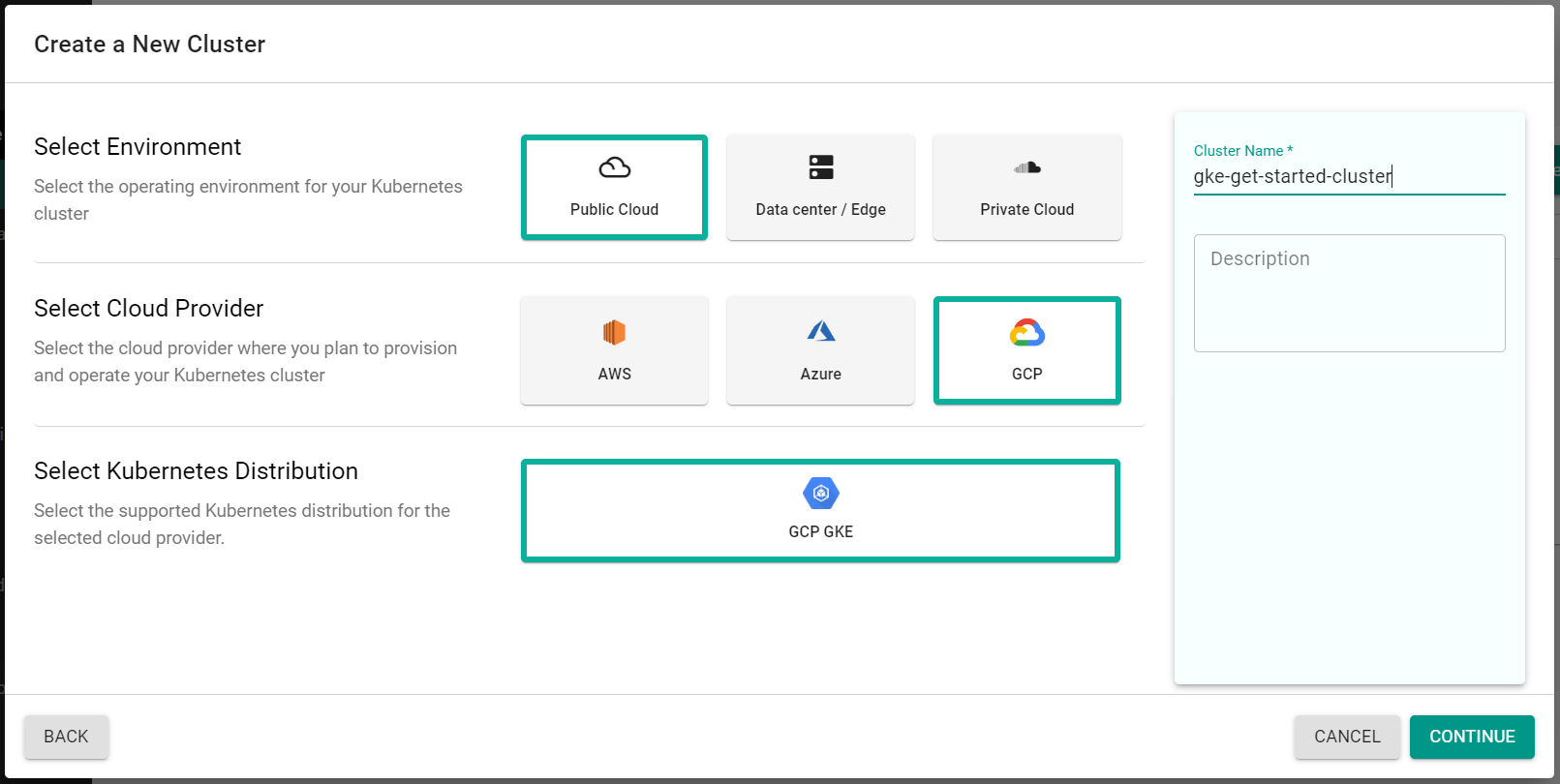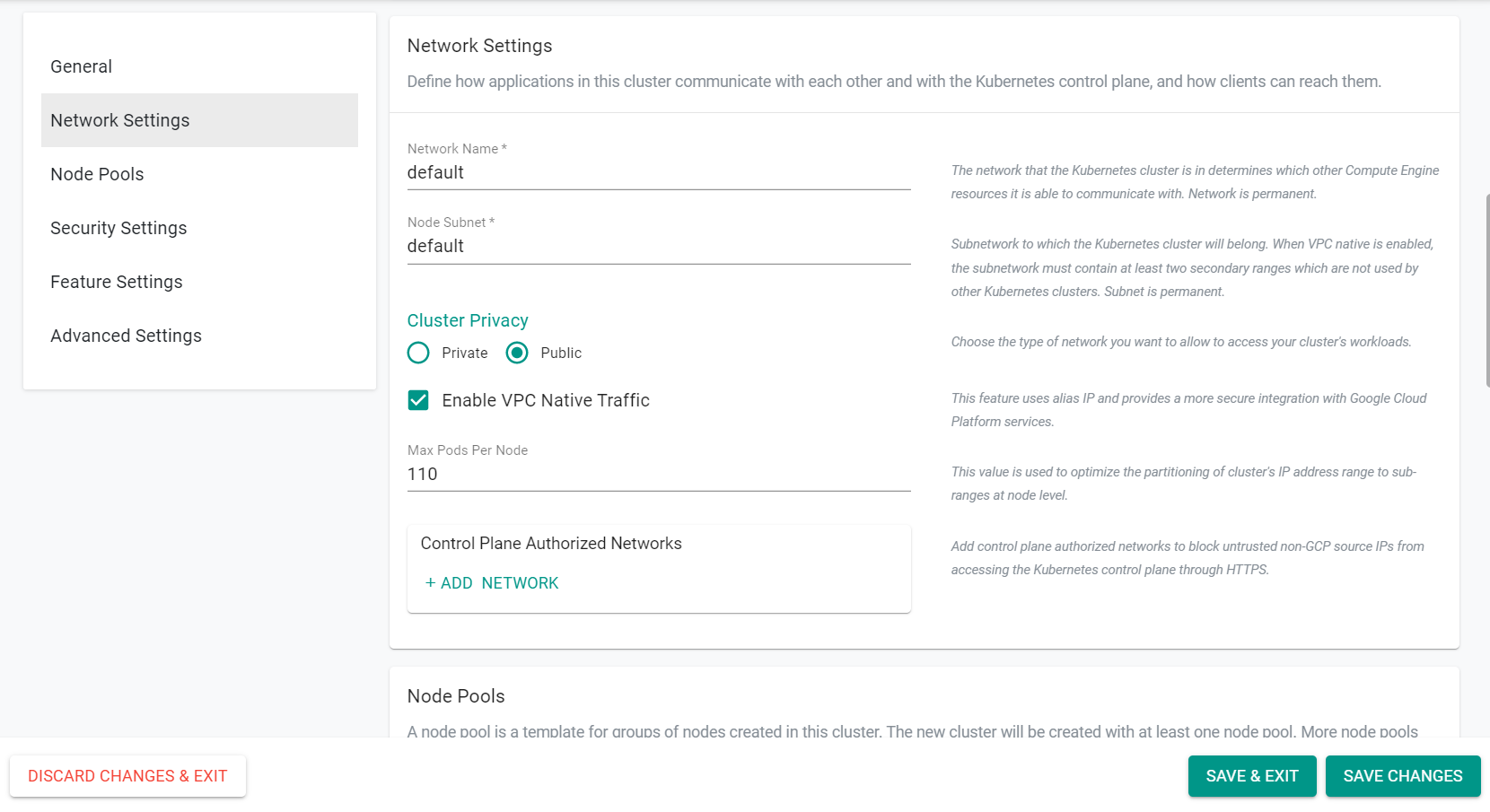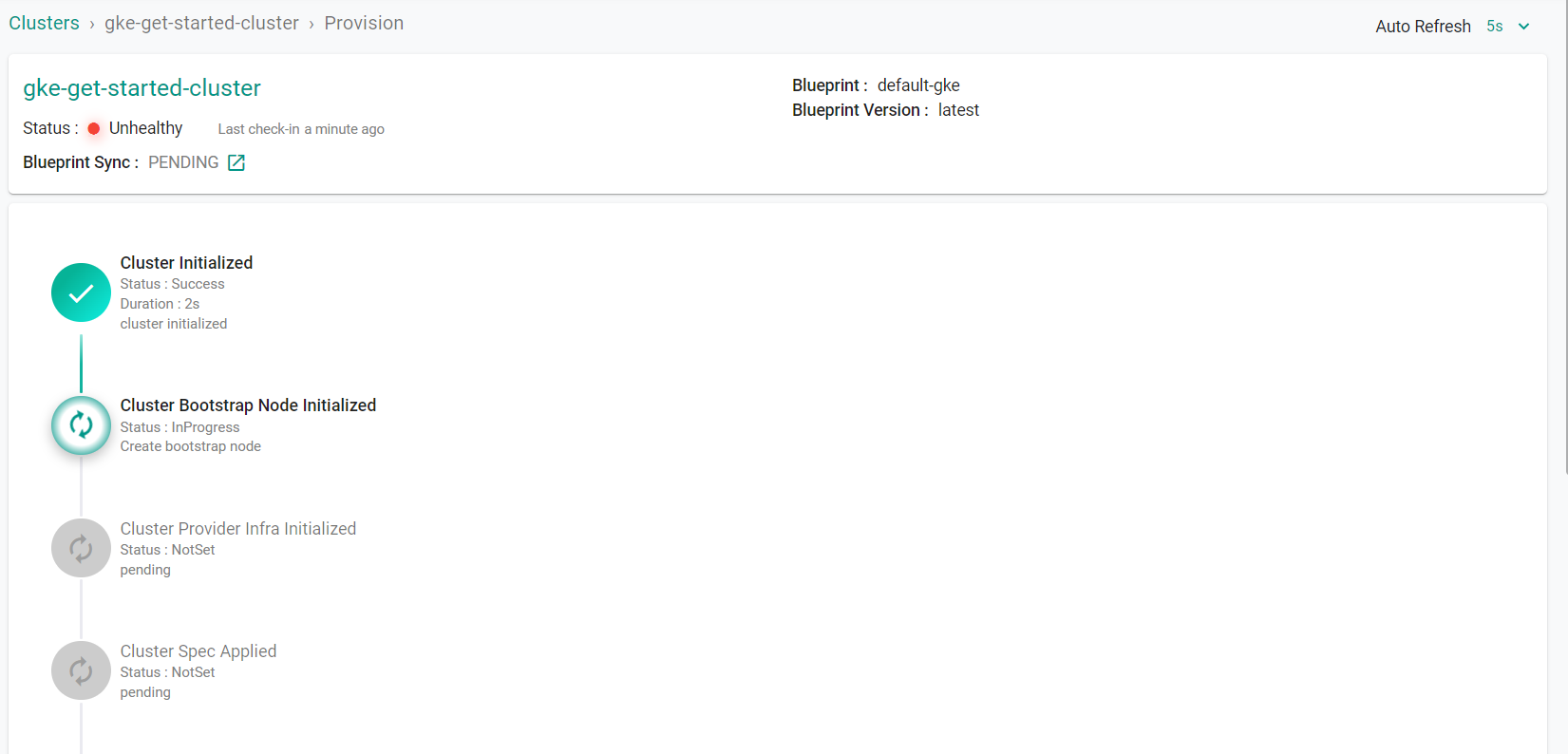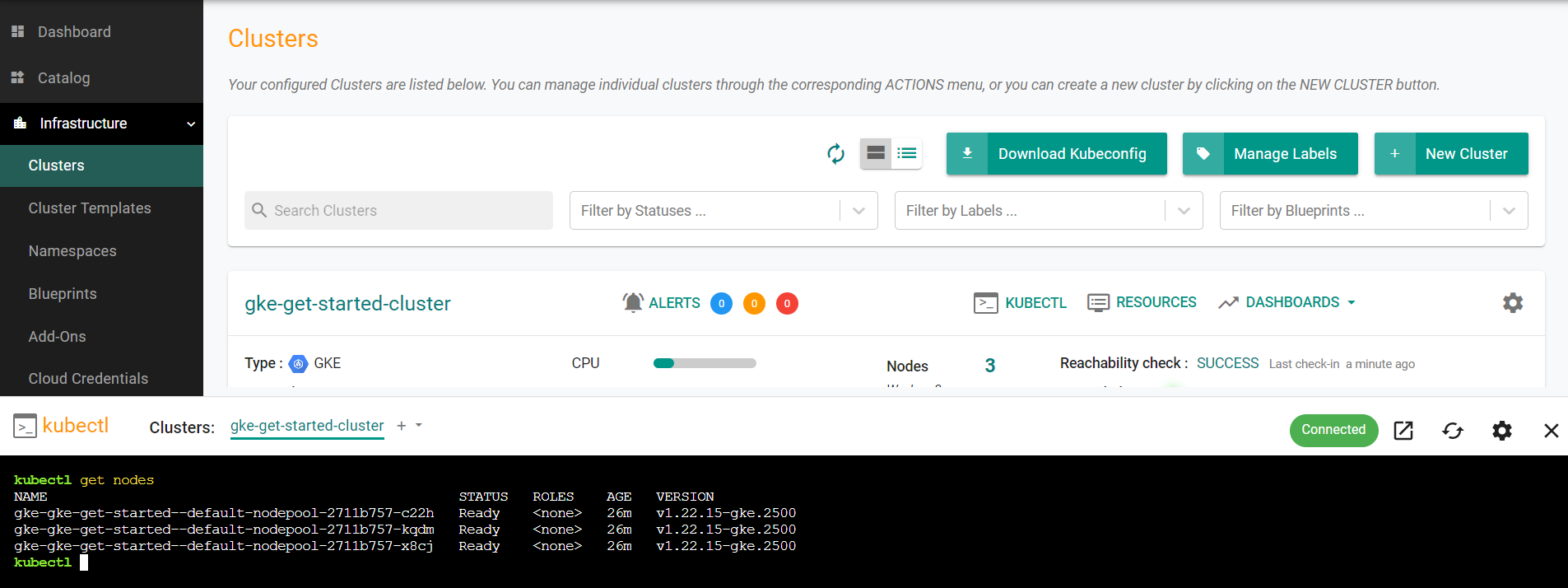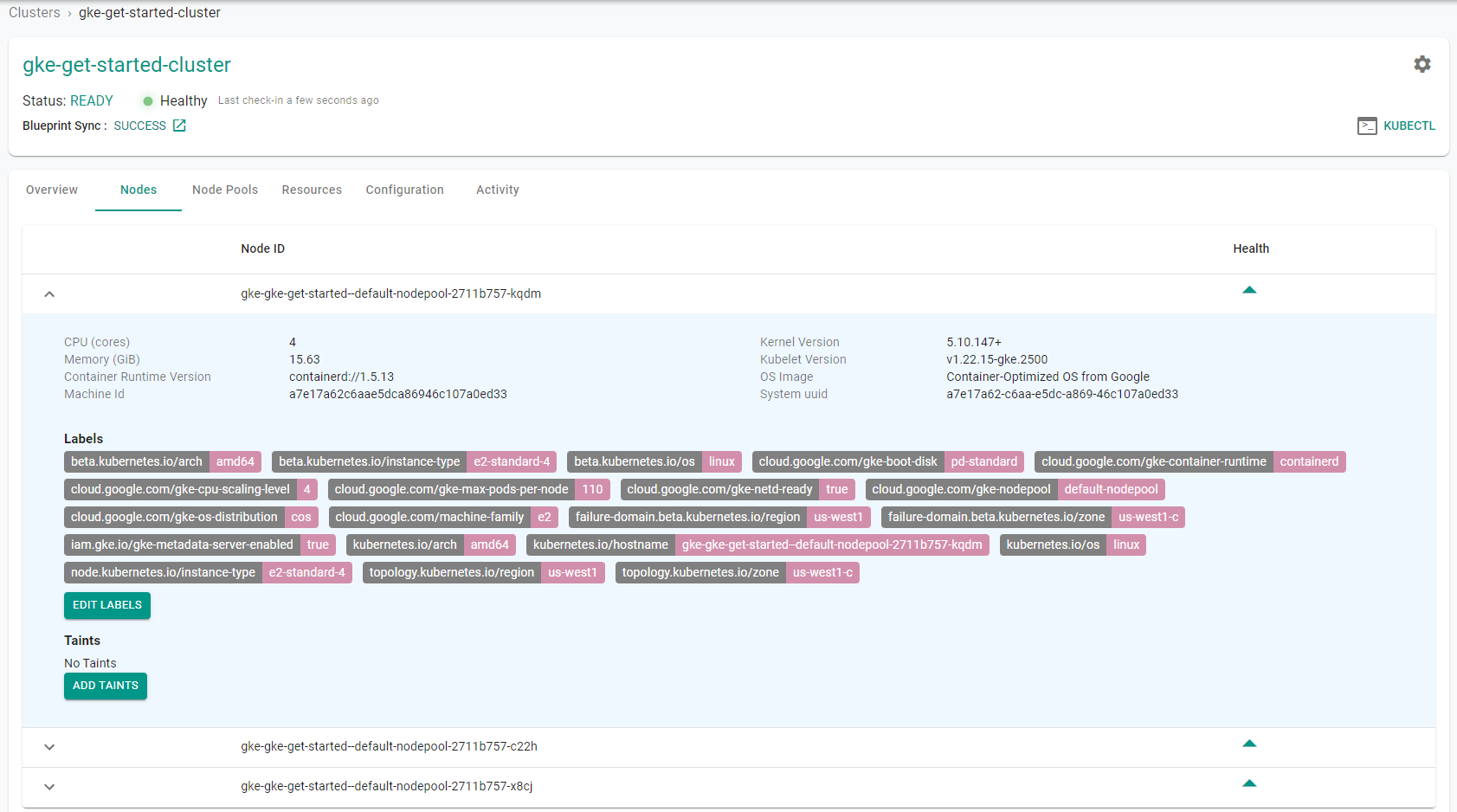Part 1: Provision
In this exercise, you will focus on provisioning a GKE cluster in Google Cloud using the web console or the RCTL CLI.
What Will You Do¶
In this part, you will:
- Create a new Project in your Org
- Create a Cloud Credential
- Provision an Google Cloud GKE cluster
- Verify cluster health
- Review available dashboards
Step 1: Create Project¶
In this step, we will create a new project which will serve as a logically isolated "operating environment" (sub tenant).
Note
Creating a project requires "Org Admin" privileges.
- Create a new project called "gke"
- Switch context to this project by clicking on the project in the web console
Step 2: Create Cloud Credential¶
Cloud credentials provide the controller with privileges to programmatically interact with your Google Cloud account so that it can manage the lifecycle of infrastructure associated with GKE clusters.
- Follow the step-by-step instructions to setup Google Cloud and obtain the required credentials.
- Follow the step-by-step instructions to create an GCP cloud credential on the controller.
- Validate the newly created cloud credential to ensure it is configured correctly.
Step 3: Configure & Provision Cluster¶
In this step, you will configure and customize your GCP GKE Cluster using either the web console or the RCTL CLI with a YAML based cluster specification.
- Navigate to the previously created project in your Org
- Select Infrastructure -> Clusters
- Click "New Cluster"
- Select "Create a New Cluster"
- Click "Continue"
- Select "Public Cloud"
- Select "GCP"
- Select "GCP GKE"
- Enter a cluster name
- Click "Continue"
- Select the previously created "Cloud Credentials"
- Enter the "GCP Project" ID where the cluster will be created
- Select the "Zone" for the cluster
- Select the K8S Version for the cluster
- Select the "default-gke" blueprint
- Under the "Network Settings" section, change the "Cluster Privacy" to "Public"
- Click "Save Changes"
- Click "Provision"
Provisioning will take approximately 15 minutes to complete. The final step in the process is the blueprint sync for the default blueprint. This can take a few minutes to complete because this requires the download of several container images and deployment of monitoring and log aggregation components.
- Save the below specification file to your computer as "gke-cluster-basic.yaml". Note, the highlighted sections in the spec will need to be updated to match your environment.
apiVersion: infra.k8smgmt.io/v3
kind: Cluster
metadata:
# The name of the cluster
name: gke-get-started-cluster
# The name of the project the cluster will be created in
project: gke
spec:
blueprint:
# The name of the blueprint the cluster will use
name: minimal
# The version of the blueprint to be used
version: latest
# The name of the cloud credential that will be used to create the cluster
cloudCredentials: GCP-CC
config:
# The kubernetes version of the control plane
controlPlaneVersion: "1.29"
features:
# Enable the compute engine persistent disk driver, required for K8s version 1.25+
enableComputeEnginePersistentDiskCSIDriver: true
# The GCP project ID where the cluster resides
gcpProject: demos-249423
location:
config:
# The GCP geo-location where the cluster resides
zone: us-west1-c
type: zonal
network:
access:
config: null
type: public
enableVPCNativetraffic: true
# The maximum number of pods that can run on a node
maxPodsPerNode: 110
name: default
subnetName: default
nodePools:
- machineConfig:
# The size of the boot disk in GB on each node in the node pool
bootDiskSize: 100
# The type of disk used for the boot disk
bootDiskType: pd-standard
# The operating system used on the nodes
imageType: COS_CONTAINERD
# The size of the VMs that the nodes will run on
machineType: e2-standard-4
# The name of the node pool
name: default-nodepool
# The kubernetes version that will run on the node pool
nodeVersion: "1.28"
# The desired number of nodes that can run in the node pool
size: 3
type: gke
-
Update the name section with the name of the cluster to be created and the project section with the name of the Rafay project you previously created
metadata: name: gke-get-started-cluster project: gke -
Update the cloudCredentials section with the name of the cloud credential that was previously created
cloudCredentials: GCP-CC -
Update the control plane version section with the kubernetes version for the control plane
controlPlaneVersion: "1.29" -
Update the zone sections with the GCP zone where the cluster will be created
defaultNodeLocations: - us-west1-c type: zonal zone: us-west1-c -
Update the name section with the name of the cluster to be created
name: gke-get-started-cluster -
Update the node version section with the kubernetes version for the nodes
nodeVersion: "1.28" -
Update the project section with the ID of the GCP project
project: demos-249423 - Save the updates that were made to the file
-
Execute the following command to provision the cluster from the specification file previously saved
./rctl apply -f gke-cluster-basic.yaml -
Login to the web console and click on the cluster name to view the cluster being provisioned
Provisioning the infrastructure will take approximately 15 minutes to complete. The final step in the process is the blueprint sync for the default blueprint's add-ons. This can take a few minutes to complete because this requires the download and deployment of several container images associated add-ons.
Once the cluster finishes provisioning, download the cluster configuration file and compare it to the specification file used to create the cluster. The two files will match.
- Go to Clusters -> Infrastructure.
- Click on the Settings Icon for the newly created cluster and select "Download Cluster Config"
Step 4: Verify Cluster¶
Once provisioning is complete, you should have a ready to use GCP GKE Cluster. We will verify the cluster by checking its health and status.
Step 4a: Cluster Status & Health¶
The Kubernetes management operator automatically deployed on the cluster by the controller will "maintain a heartbeat" with the controller and will "proactively monitor" the status of the components on the worker node required for communication with the control plane and the controller.
Step 4b : Zero Trust Kubectl¶
The controller provides a zero trust kubectl channel for authorized users.
- Click the "Kubectl" button on the cluster card.
- This will launch a web based kubectl shell for you to securely interact with the API server over a zero trust channel
Step 5: Dashboards¶
The default cluster blueprint automatically deploys Prometheus and related components required to monitor the GKE cluster. This data is aggregated from the cluster on the controller in a time series database. This data is then made available to administrators in the form of detailed dashboards.
Step 5a: Cluster Dashboard¶
Click on the cluster name to view the cluster dashboard. You will be presented with time series data for the following
- Cluster Health
- CPU Utilization
- Memory Utilization
- Storage Utilization
- Number of Worker Nodes
- Number of workloads and their status
- Number of pods and their status
Step 5b: Node Dashboard¶
Click on the node tab and then select a node to view the node dashboard.
Step 5c: Kubernetes Resources¶
The dashboard also comes with an integrated Kubernetes dashboard.
- Click on "Resources" tab and you will be presented with all the Kubernetes resources organized using a number of filters.
Recap¶
Congratulations! At this point, you have
- Successfully configured and provisioned a GCP GKE cluster
- Used zero trust kubectl to securely access the GKE cluster's API server
- Used the integrated cluster, node and k8s dashboards to monitor and view details about the cluster



